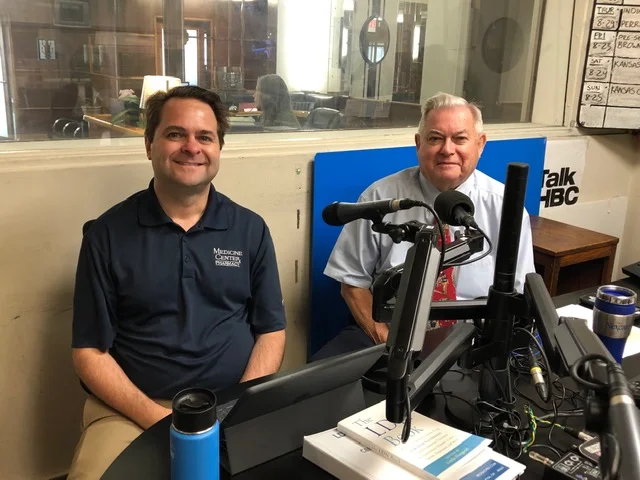Coronavirus and the Protocol Established by our Local Health Departments.
Health Matters is a weekly radio show sponsored by the Medicine Center Pharmacy on WHBC 1480 AM in Canton, Ohio. This episode pharmacists Brad White and Paul White discuss coronavirus with Mark Adams, Health Commissioner for Henry County and former Director of Environmental Health at Canton City Health Department.
You can find all our Health Matters Podcasts here: iTunes Google Play Stitcher
It is impossible to escape the news and concerns spreading in both our community and globally about coronavirus. Locally as health care professionals who are concerned are directed toward influenza currently. Statistically, we can expect an 8% of the population to develop the flu, 1% of those with influenza to become ill enough to require hospitalization, and 0.05% of people with influence to die from the virus. If you're wondering how the coronavirus compares to influenza and what our state and local health departments are doing about coronavirus.
We'd like to remind our listeners today that our program is available on our podcast. You can search the App Store for “Health Matters with the Medicine Center Pharmacy” and listen to any of our programs anytime. You can also post up the questions you have today to our live Facebook feed. [01:33]
Mark Adams: Tell us about yourself
I was at the Canton Health Department for 25 years; leaving there as the Director of Environmental Health. And two years ago came out here to Henry County to serve as the Health Commissioner. And things are wonderful. It is a completely different change in public health going from a lot of environmental health issues that exist around sanitation and issues like that to coming out to one that deals now with sewage. The health department in a much smaller county provides a lot of the other types of health care. For example, in Henry County, we have only had a pediatrician part-time for a very small period of time: one pediatrician. So, the health departments out here in Northwest Ohio have to provide a lot of that care or be able to contract with somebody or work with other people to provide that care for the citizens to make sure that they're just as healthy here as they are in other places that have more resources. [02:38]
What is coronavirus? How did it get its name?
Well, it's named as such because of the way it looks. If you look at it, it’s this round virus that has these spiky projections and it resembles a crown. So, it was named coronavirus after the word Corona, which is in Latin.
There are seven coronaviruses that can be transmitted from human to human. To give an example, people might remember if I mention SARS, back in 2002-2003, or MERS (Middle East Respiratory); those two were also coronaviruses. [04:51]
Why did they call this the novel virus?
It's novel because it's new. So, they discovered it around the third week of December 2019. Now they have moved away from calling it coronavirus 2019 to COVID-19, which means “CO” for coronavirus, “VI” for virus, and “D” for disease, and then dash 19 because of the year it was discovered. [07:11]
Where did it come from?
In most cases, coronaviruses are easily carried by bats. They don't know exactly how that interaction took place between a bat and a snake, and how it resided in that snake but I have heard and have seen information on from both WHO and CDC and it's been reported to us that if we're going to prevent it and we're going to create a vaccine, we have to know where it started, we have to know everything we possibly can about that virus. So, that's why we try to find out exactly where it was coming from, and how that transmission went from animal-to-animal to animal-to-human. So in this case, we suspect that the market that had snakes, somehow by handling those snakes, a human was able to get it. Well, that happens that we can get something from an animal, we pay attention to that, it's a concern to us, but the main concern is when it goes from human to human because of how mobile we are. So, if you think about if we do confirm that it was transmitted from snake to human, that snake it's already in the market, it's not that mobile but we are absolutely that mobile and especially we're global. And it concerns us when it goes human to human because of how fast we can spread it. [08:03]
Are the symptoms just the same as the flu?
Absolutely, almost identical. In fact, even when it comes down to prevention, almost exactly like the flu. So they're very similar to that general malaise, fever. That's why you might see them using thermometers on the forehead to look and see if a person is already experiencing a fever, and that's where they've been stopping some people from leaving certain areas of China or before they enter certain areas. That's their quick way of doing it, and only other way of doing would be, of course, doing a confirmed lab test. [11:04]
Not really, it spreads the same way. So, if we are infected, we cough, sneeze those droplets; a person is very susceptible if they're within about six feet of a person that’s sick. So that's actually that's pretty far away when you think about what six feet is. So, the flu and coronavirus can be spread easily from human to human because of those droplets. And also, those droplets: if they land on a surface or if a person uses their hand and they cough into their hand, that virus then gets transferred to that surface. It's viable for quite some time and that person that comes in behind it, and touches that surface, whether it was a door handle, a phone, computer, keyboard, and if they touch that to their mouth in any way, they can then get sick, they can transfer that virus to themselves. So, it can either be human to human through the droplet in air or human to human through the droplets that have landed on a surface; so from surface to human. [16:17]
Coronavirus vs Influenza vs SERS vs MERS
If we look at MERS (Middle East Respiratory Syndrome), that has about a 35% fatality rate. So, that one is very extremely high. If we look at SARS, it was about a 9% mortality rate. Right now, coronavirus has actually gone down a little bit from its original to about 2%. It was at around two and a half percent. So there is a live feed so we can track this. And right now there's a total overall 64,000 cases, so a little over 64,000 and 1,300 deaths. And the recovery rate is starting to go up. So, if we just looked at the flu, last year alone in the United States killed a little over 30,000 people. So, it’s with millions of people, approximately 32 million people affected; 16 million people go into the hospital, meaning that about 16 million people stayed home with symptoms. They didn't seek out care. Hundreds of thousands of people are being admitted to the hospitals, with flu. With coronavirus it's so much less. Now, I don't say that to be able to say, “All right, let's not pay attention to it.” If anytime that we have a virus that we don't know a ton about that has the ability to go human to human, we want to know everything about it. The mortality rate is unknown in a population, so the more information we can gather about an illness and how it affects the population will provide better protocols for containment and treatment because it always has that potential to have an impact. A virus is no different than us: we change. Our genome, or every time we have children, they take on traits of both mother and father. Viruses do the same way: they change. And when they do that, they can adapt, and they look a little bit different in their next version [19:51]. So, we want to know everything about it. That's why we want to know where it came from, what animal it started in, and how it was able to get transmitted, we can stop it there first, before a vaccine. And then after the vaccine, if we need to produce a vaccine, then we get a vaccine. [17:29]
What are the precautions?
Few precautions should be taken whether you have caught coronavirus or the flu:
● If you're sick, stay home. If you're a business owner and you have the ability to allow sick leave then allow it, encourage it; you don't want to infect the rest of your workforce.
● Avoid close contact with people who are sick.
● Avoid touching your eyes, nose, and mouth with unwashed hands. So, regardless of if you are healthy or ill, wash your hands using soap and water: 20 seconds, some people use the alphabet, there's other ways of doing it but just soap and water. A lot of people think that you can actually overdo it with alcohol. Soap and water is perfect.
● If you do cough or sneeze do so in a tissue and discard that tissue. Don't keep it or put it in our pocket. Try not to use a handkerchief where it's multiple use, that virus just sits in there, and it just becomes this active biohazard that you're going to keep in your pocket, on your personal self. [26:18]
Do you really need a facemask?
I know that a lot of people are watching the news and they're seeing facemasks. There's no need to go in and do a rush because the same continual snapshots of people wearing facemasks end up on TV or whatever source that you're getting your news from. And then that starts saying, “Well, if I'm not seeing people without facemask, maybe I need to go get a facemask,” that is just not the case. [27:17]
What are the reliable sources of information?
Many nations are becoming educated on YouTube, and pretending to be professionals after we read something on YouTube. We're making YouTube lawyers now, we're YouTube public health people. And we've really got to get away from those types of sources. While they are some things that are fun to watch, we really need to get a reliable source. If it's going to concern coronavirus or flu, I promise you the only place that's everyday updating where their surveillance is coming from, where they're getting information from, it's going to be cdc.gov, or the Ohio Department of Health at odh.ohio.gov, or your local health department: at Canton it’s cantonhealth.org, at Henry County residents in Napoleon it’s henrycohd.org. So, we're posting information every day on it, as most every single health department in Ohio is. We're on conference calls with the Ohio Department of Health; every day we receive an updated information packet from the Ohio Department of Health with what's currently going on, and it usually gets produced and sent out prior to midnight. So, we have very active surveillance measures that are not being covered everywhere else. Our job is to spread as much information that's true, and it's data oriented, not feeling oriented. So, I'm hoping that people can see the difference between how they feel about something and what they're actually getting data on, and go to those sources. And always double check what you're reading and say, “Can this even be real?” [34:06]
Summary
Finally, to summarize, we started with Mark giving his brief introduction and background. We then discussed coronavirus: it’s name, origin, symptoms and precautions. We compared coronavirus and some of its types with the flu. We also discussed the significance of facemasks. And lastly, we looked at some reliable sources of information to stay updated.





We've had a lot of questions about CBD in the pharmacy and as you drive around town and see signs everywhere from on telephone poles to gas stations and video stores. It's kind of make you wonder, “Okay, what's the deal with CBD?”.